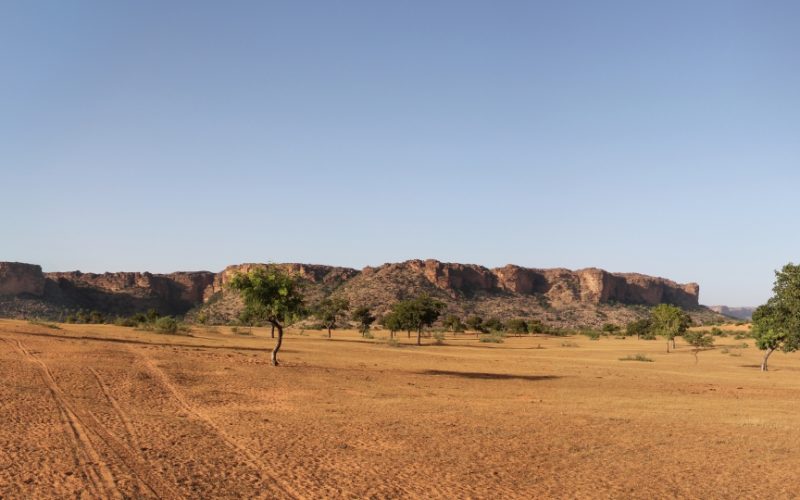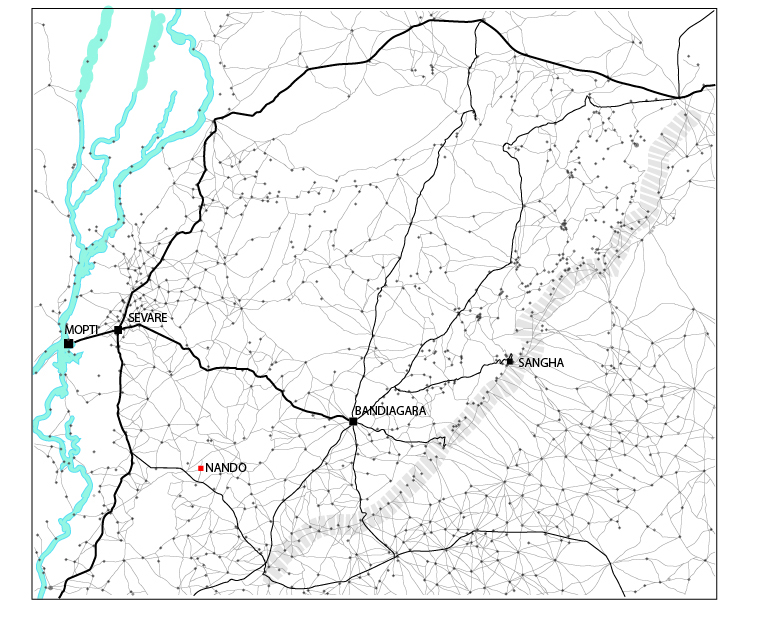The Cliff of Bandiagara (Land of the Dogons) was inscribed on the List of World Heritage properties in 1989. It was inscribed as a cultural and natural site on the basis of criteria V and VII, and is one of the largest mixed sites inscribed in the World Heritage List of UNESCO. It extends over 4,000 km2 and, as such, is an area where around 500.000 people are living in 289 villages. Nando is one of these villages. Among them, Nando holds a special status due to the unique mosque which lies in the centre of the village.
The land of the Dogon lies south of the river Niger not far from Mopti and Djenne. The region is composed of three zones: the plateau, the cliffs and the lower plains. The plateau rises like an immense fortress to a height of approximately 300 metres above surrounding plains. It is delimited by the Bandiagara escarpment, a cliff of more than 200 km long, which runs from southwest to northeast. Successive waves of immigration have populated the area. Over the ages peoples from different horizons had to share, not often without harm or conflicts, the same territory. Today the originality of Dogon country resides in its ethnic, cultural and linguistic diversity. A homogeneous Dogon society does not exist. Like so many other farming societies, the Dogon have no centralized power structure. Political and religious authority belong to the village elders. In line with its diversity, each region of the Dogon land has its own traditions. Variants in belief, myth and history abound.
In the Pinari, on the plateau near Mopti, are several unique villages like Pah, Niongono, Nombori and Nando which are especially mentioned on the Unesco list for their extraordinary quality. The village of Nando is well known for its 600 year old mosque, that presents a very different appropriation of the well known West-African traditional mosque architecture, exhibited in the more commonly known Great Mosque of Djenne. In the last 15 years lot of fieldwork has been done in the village of Pah, but this could not prevent the exodus of the village and the almost complete collapse of the monument. The village of Nando is also threatened by a similar prospect. For this reason the Foundation Dogon Education has become a partner of the village for preventing this. Since 2007 the Foundation has worked on improving the water situation by making wells and a pump installation in cooperation with the village and by building schools in the nearby villages Pah and Balaguina.
In 2009 we started in small steps with the local community to restore some buildings, the gate and the mosque. The experience we derived from this work and process forms the basis of this project proposal.
The project presented in this document has been prepared by the Foundation Dogon Education in collaboration with LEVS architects Amsterdam, The NAi (Architectural Institute of the Netherlands) and the Mission Culturelle de Bandiagara, the decentralised government structure in charge of the protection and conservation of the Unesco site. The project will be supported in the future by several partners listed in the credits. The start of the project is a response to the concerns expressed by the leaders of the village of Nando and the inhabitants who are very eager to continue their life in the village to maintain the unique mosque of Nando, and their knowledge of the fast decline of the nearby village Pah.




